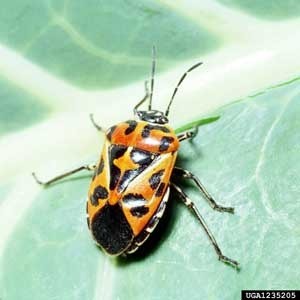
Identification
Look for black and red or black and yellow winged beetles that are 1/2 inch long and shaped like a shield. Adults lay tiny eggs in rows or masses on the undersides of leaves that hatch into nymphs. These look like miniature versions of the adult beetles. Both adults and nymphs may overwinter in leaves or yard waste.
Favorite Plants
This insect prefers to feed on horseradish, cabbage, cauliflower, collards, mustard, Brussels sprouts, turnip, kohlrabi and radishes. Depending on the food supply, it may also attack tomatoes, potatoes, eggplants, okra, beans, asparagus, beets, and fruit trees.
Damage
Harlequin Bugs cause plants to wilt, turn brown and die by literally "sucking the juices right out of them."
Organic Methods of Control:
Cultural or Mechanical
- Plow crops under in the fall.
- Hand pick bugs, nymphs and eggs off of plants.
- When possible, plant cultivars tolerant of this variety (some radishes and collards).
Biological
- Attract praying mantis to eat adults and nymphs.
Chemical
- Spray bugs and nymphs with soap spray.
- For severe infestations, use pytrethrin sprays as a last resort.
